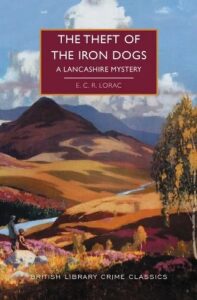The Theft of the Iron Dogs strikes me as a pleasing and intriguing title for a crime novel. The author, E. C. R. Lorac, published more than seventy books, but this has long been one of the most highly regarded mysteries. The novel was first published by Collins Crime Club in 1946, but its title proved to be rather too mysterious for Lorac’s American publishers, who brought it out the following year. They opted for the commonplace, renaming the novel Murderer’s Mistake.
A particular strength of the novel is the period atmosphere. The story opens in September, and the early paragraphs begin with a description of harvesting time in the dairy farming district, where “the war effort had not been concerned with the nervous energy required by resistance to bombs or doodles or rockets; it had been the strain of sustained physical effort.” We are introduced to a farmer (and former book dealer) called Giles Hoggett, of Wenningby, and one rainy day he decides to go fishing. He takes a look at a summer cottage, only to find that two iron dogs are missing from the fireplace, as well as a complete reel of salmon line, a strong chain and hook, a clothes-line, a raincoat, and cap—and a large sack. Giles’s wife is amused: “I told you if you read so many detective stories you’d be getting the subject on the brain. I quite agree you could make a good story out of ‘The Burglary at Wenningby Barns,’—so the best thing you can do is come home and write it, while you’re in the mood. Crime pays much better than cows.”
Giles consults John Staple, who met Chief Inspector Macdonald the previous year in connection with the events described in Fell Murder (which, like Crook o’ Lune, has been published as a British Library Crime Classic) and decides to consult the Scotland Yard man. When he receives Giles’s letter, Macdonald has “a momentary vision of Crook o’ Lune, shining in the September sunshine, and Ingleborough behind him, with Penyghent and Whernside.” He has already fallen in love with the area; he loves walking and is also interested in fishing and the farmers’ way of life. Lorac’s own love of Lunesdale will be evident to anyone who reads this novel. She doesn’t sentimentalise, but her ability to evoke the landscape and—crucially—the people who make their livelihood from it is a key strength of her writing. It is significant that the central crime comes to light because the person responsible “was lacking in in a sense of detail and of real understanding of the inhabitants.” At the end of the story, we learn precisely why the theft of the iron dogs was such an important clue.
Macdonald needs no second invitation to make a few discreet enquires, arriving in Lunesdale, only for it to turn out that he and Giles actually had a brief previous acquaintance on the rugby pitch. A friendship begins to blossom between the detective and the Hoggetts.
By the time she came to write this book, Carol Rivett (Edith Caroline Rivett, whose principal pen-names were E. C. R. Lorac and Carol Carnac) was well-established as a detective novelist, with two long series being published by Collins Crime Club. During the war, she had moved to Aughton in Lunesdale to be close to her sister Maud Howson and her husband John. John was a former headmaster, while Maud had been educated at university at a time when that was relatively uncommon for women. In 1962, Maud wrote an interesting and rather poignant account (which can be found online) of her family’s voyage from Australia to England in the sailing ship Illawarra in 1900, at a time when she, Carol, and their sister, Gladys, were young, and their father was dying of tuberculosis.
The Theft of the Iron Dogs is dedicated to Maud and John, and they were the real-life models for Kate and Giles Hoggett. John had a brother called Giles. Lena Whiteley, who knew both Maud and Carol, remembers Maud as a keen plantswoman, as was Carol, and it’s no coincidence that in the story, Kate does most of the work in the Hoggetts’ garden. Maud had a strong social conscience (as did Carol) and had worked in a soup kitchen in the 1930s.
The British Library’s Crime Classics series has resulted in the revival of interest in many authors, none more so than Lorac. Her gift for evoking place appeals to many readers, while the variety of her settings and storylines also helps to explain her popularity. It is strange to think that she was, for nearly sixty years after her death in 1958, an author forgotten by all but a handful of detective fiction devotees. The Crime Classics series includes, at present, one novel published under the Carnac name (Crossed Skis) as well as a novel never published during the author’s lifetime (Two-Way Murder). Her Lunesdale novels were among the personal favourites of my parents, who first introduced me to her writing. I have no doubt they would have been delighted to see this book back in print, and so am I.
***


















